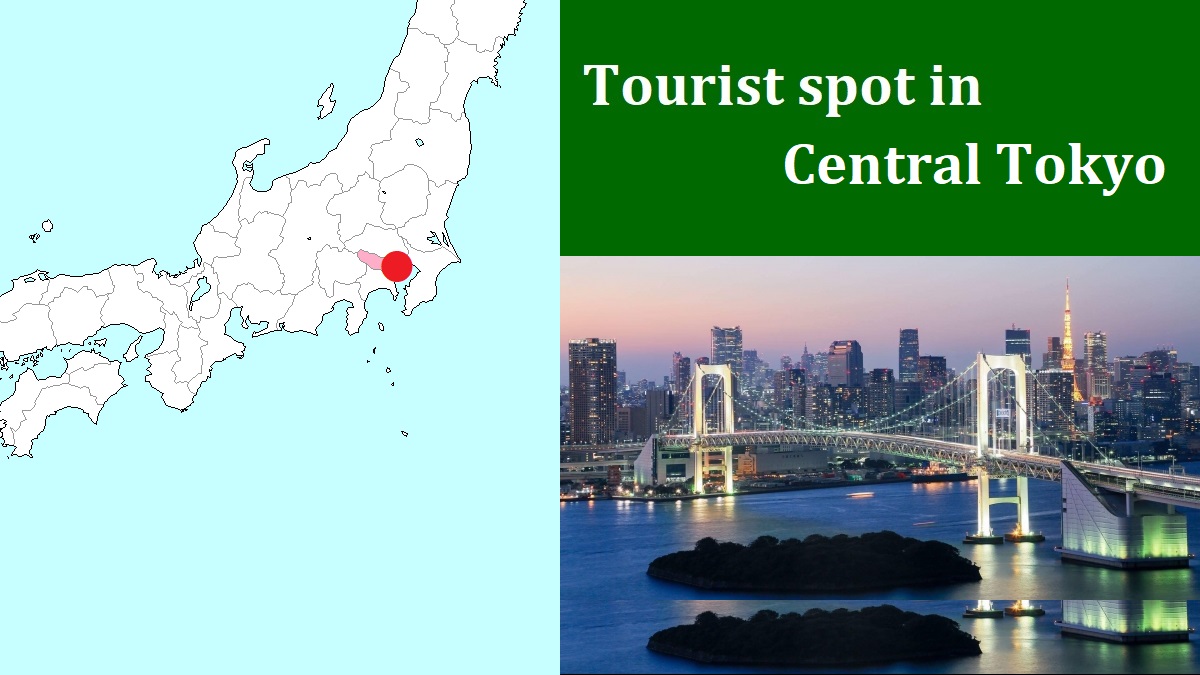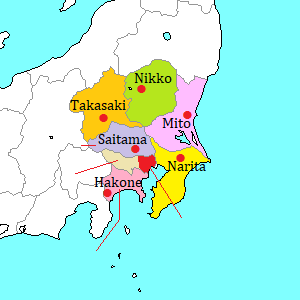Shibuya [渋谷]
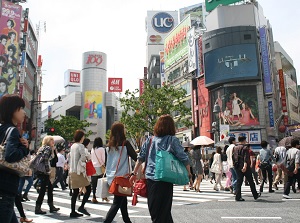
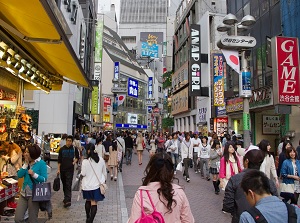
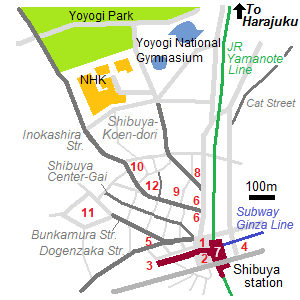
1) Hachiko Square 2) Statue of Moyai
3) Shibuya Mark City 4) Shibuya Hikarie
5) 109 6) Seibu 7) Shibuya Scramble Square
8) MODI 9) LOFT 10) HANDS
11) BUNKAMURA 12) Spain Slope
Shibuya is an area located about 3 km south of Shinjuku.
There are many department stores, various shops, restautants and cafes in the area.
Many office buildings are also in this area, so a busy town is formed.
Culture and fashion are featured in this area.
Shibuya has been a trendsetting town of fashion in Japan along with Harajuku since the 1970s.
The commercial facilites such as PARCO and 109 has attracted young women with fashion since the period.
The center of the area is Shibuya station.
Shibuya area is in the valley.
Shibuya station is at the bottom of the valley, and the west and east areas are on the upslope.
The topography of this area is complex, so most of the streets are not straight and have many slopes.
Mainly, shopping and amusement district is to the northwest of Shibuya station.
And some main streets extend radially from the station.
Around Shibuya station
Shibuya of JR Yamanote, Saikyo Lines is the central station of Shibuya.
It runs from north to south and separates the town into east and west.
The building just above the station is Shibuya Scramble Square.
There are big buildings with commercial facilities by the station.
Shibuya Hikarie is to the east side of the station, and Shibuya Mark City in to the west side.
From the buildings, subway Ginza Line starts to the east and Keio Inokashira Line starts to the west.
In front of the station, there are some popular spots.
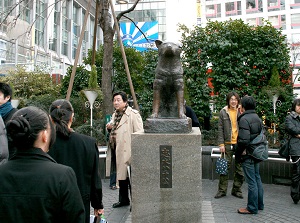
Statue of Hachiko
Statue of Hachiko (ハチ公像)
It is the popular bronze statue of a dog named "Hachi" in front of the JR Hachiko exit of the station.
It is a popular meeting spot.
("Hachiko" is the nickname of "Hachi".)
In the 1920s, a professor had kept Hachi.
Hachi had waited for him to come back from his university at Shibuya station every day.
But he had died suddenly in 1925, however Hachi had come to wait for him there every day for 10 years.
Hachi's faithful behavior had impressed many people, so this statue was built in 1934, while Hachi was alive. (Hachi died in 1935.)
The station square in front of this statue is called Hachiko Square (ハチ公前広場).
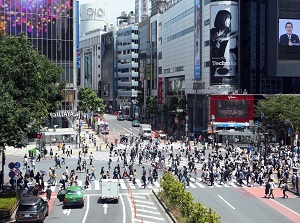
Pedestrian scramble by Hachiko Square
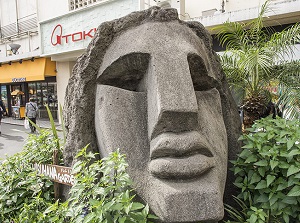
Statue of Moyai
Pedestrian scramble
There is popular pedestrian scramble in front of Hachiko Square.
When you walk around the northwest area of Shibuya, you will cross this.
Pedestrians can cross the intersection for about 45 seconds.
After that, cars run through the intersection for about 90 seconds.
About 500 thousand people cross the intersection in a day.
And, when special event is held around Shibuya, it is said that about 3,000 people cross at one time.
But most people keep the rules.
So, few traffic accidents have occured here.
Recently, some pedestrians sometimes ignore the red light.
Please obey the traffic rules.
Statue of Moyai (モヤイ像)
It is also a popular meeting spot in front of the west exit of the station.
It is located about 50 meters south of Statue of Hachiko.
It was a stone statue built in 1980.
Because it is similar to "Moai" in Easter Island, it is called this name.
Northwest area of Shibuya
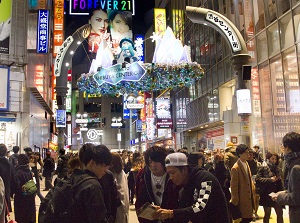
Entrance of Shibuya Center-Gai
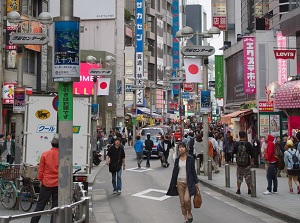
Street of Shibuya Center-Gai
Shibuya Center-Gai (渋谷センター街)
It is the town along a street extending to the northwast from the pedestrian scramble.
The width is relatively narrow, and the length is about 350 meters.
Along the street, there are many restaurants, fast-food shops, game arcades and various shops.
Many of the visitors are young people in their teens and twenties.
By the way, the main street of this town was named as "Basketball Street" in 2011.
But it seems that the name has not been prevailed in the public.
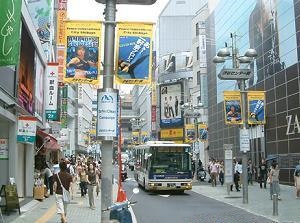
Inokashira street
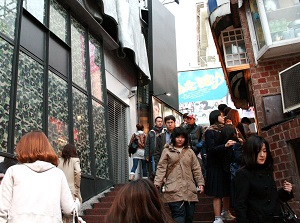
Spain Slope
Inokashira street (井の頭通り)
It is a street one block north of Shibuya Center-Gai.
The street has gentle slope.
There is Seibu Department Store at the entrance of the street, and a few big stores of general goods such as LOFT, TOKYU-HANDS are along the street.
On the way, there is a narrow and steep slope with stairs to the north.
There are small shops with the style of southern Europe along this road.
This slope is called Spain Slope.
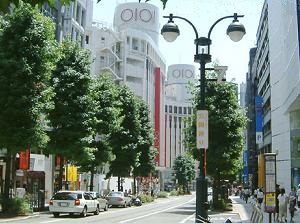
Shibuya Koen-dori
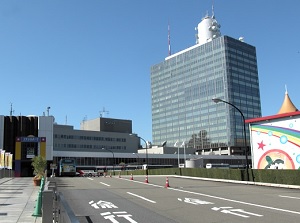
NHK Broadcasting Center
Shibuya Koen-dori street (渋谷公園通り)
It is a street branching off at one block north of Inokashira street.
It extends to the north-northwest.
It is a slope from the intersection, and the length is about 450 meters.
"Koen-dori" means "Park street", so this street leads to Yoyogi Park.
There is the departmentstore of fashion MODI at the entrance of the street.
At the northwest end of the street, there is NHK Broadcasting Center which is the headquarter of Japan's national public broadcasting organization.
There is a tour course for visitor.
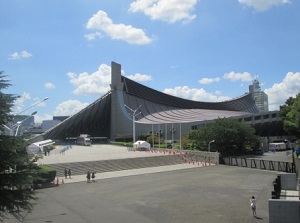
Yoyogi National Gymnasium
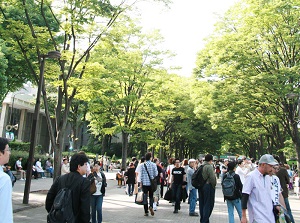
Yoyogi Park
Near NHK, there is Yoyogi National Gymnasium.
It is an arena built for Tokyo Olympic Games in 1964.
It is famous for its suspension roof design by Kenzo Tange (1913-2005, a worldwide Japanese architect).
To the north, there is Yoyogi Park.
It is an wide park with many trees and has an area of 54 hectares.
This park adjoins the forest of Meiji Shrine on the northeast side.
West area of Shibuya
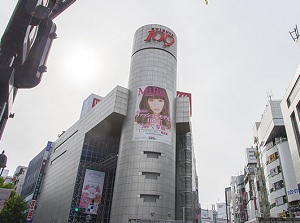
Shibuya109
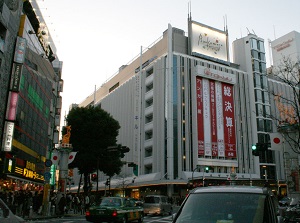
Bunkamura street
Dogenzaka street (道玄坂)
It is a street extending to the west from the pedestrian scramble.
It is a slope street, and there are many shops and offices along the street.
It is the busy street along with Shibuya Koen-dori street.
There is a department store of fashion 109 about 100 meters west from the pedestrian scramble.
It was opened in 1979, and is like a landmark of Shibuya.
"109" is read as "Ichi-maru-kyuu".
The name comes from the opening time from 10 a.m. to 9 p.m.
Bunkamura street (文化村通り)
It is a street branching off in front of 109.
There is Bunkamura about 200 meters up the street.
Bunkamura is a commercial complex with the facilities of culture and art.
It has a concert hall, a theater, a cinema,and some other facilities.
"Bunkamura" means "village of culture".
How to get here
- By JR Yamanote Line, 6 minutes from Shinjuku, 24 minutes from Tokyo.
- Nearest stations of subway.
Shibuya (●G01 Ginza Line, ●Z01 Hanzomon Line, ●F16 Fukutoshin Line)

